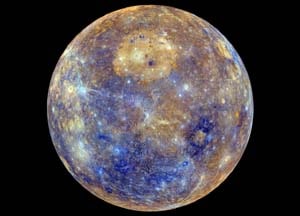English Documentary on Mercury with Transcript, illustrated flashcards and podcast to improve your listening, reading and vocabulary for IELTS and TOEFL
Source of documentary: National Geographic YouTube Channel
Mercury
The planet Mercury is named after the messenger of the Roman gods because even the ancients could see how swift and fleeting it is in the sky. But it was not until recently that scientists began unraveling Mercury’s many mysteries.
Mercury’s size and structure
Mercury is the smallest planet in our solar system. Its diameter currently measures just over 3000 miles, about the size of the continental United States. Like Earth, Mercury is a terrestrial planet with three main layers, a core, a mantle, and a crust. Only Mercury’s crust has no tectonic plates. Also, its core is enormous by comparison, making up 85% of its radius, while Earth’s inner and outer core account for just 55%.
Because of the core’s exceptional size, it’s had a surprising influence on Mercury’s overall size by causing it to shrink. The hot iron core has slowly cooled and contracted over the plant’s 4.5 billion years. In doing so, it pulled Mercury’s surface inward and has caused the planet to shrink radially by more than four miles.
Mercury’s atmosphere
This shrinking planet is also the planet closest to the sun, orbiting our solar system’s star at an average distance of roughly 36 million miles. Such proximity affects Mercury’s atmosphere or rather, the lack of one. It only has a very thin exosphere, which is traditionally the outermost layer of a planet’s atmosphere. This exosphere is made of oxygen, sodium, hydrogen, helium, and potassium, all whipped up from the planet’s surface by solar winds.
A planet of extremes
The lack of atmosphere and close proximity to the sun also makes Mercury a planet of extremes. The surface temperature can climb to 800 degrees Fahrenheit during the daytime and fall to 290 degrees below zero at night. Mercury’s proximity to the sun is also the reason behind its age-old reputation of being swift and fleeting.
Mercury’s orbit
The sun’s gravity pulls harder on Mercury than any other planet, and like all planets, Mercury travels in an elliptical orbit slowing down when it’s father away from the sun and accelerating as it draws closer. Clocking in at an average speed of over 100,000 miles per hour, Mercury slings around the sun in just 88 days.
Observation of Mercury
From Earth, Mercury is difficult to observe because it is fleeting and so close to the sun. And so far, it’s only been visited by two spacecraft, NASA’s Mariner 10 and Messenger. Those missions gave us much of what we know today, but future ventures are in the works with high hopes of revealing more of Mercury’s secrets.




Mercury the nearest planet to the sun.
D.r what does (Mariner 10 and Messenger. ) means?
Thank you for the information, Soroosh!
Mariner 10 and Messenger were two spacecrafts owned by NASA, which were used to observe and study Mercury. In fact, much of our current information about this planet has been obtained by these two spaceships.
Hello Dr.Hariri, I have a question: what does clocking here mean? ( Clocking in at an average speed …)
Hi Armaghan,
Yes, sure. Anytime.
In this context, clocking in means to go around or orbit something, here the sun, like the handles of a clock in its circuit, and the center of the clock is the sun.
As a phrasal verb, clock in means to register arrival for work or to punch in the special card when you arrive at work. Yet, it doesn’t make any sense in this context.
Mercury
The planet Mercury is named after the messenger of the Roman gods because even the ancient could see how swift and fleeting it is in the sky. But it was not until recently that scientists began unraveling Mercury’s many mysteries.
– Mercury size
Mercury is the smallest planet in our solar system. It is diameter currently measures just over 3000 miles, about the size of the continental United States.
– Mercury layers
Like Earth, Mercury is a Terrestrial planet with three main layers, a core, a mantle, and a crust. Only Mercury’s crust has no tectonic plates. Also, its core is enormous by comparison, making up 85% of its radius, while Earth’s inner and outer core account for just 55%.
Because of the core’s exceptional size, it’s had a surprising influence on Mercury’s overall size by causing it to shrink. The hot iron core has slowly cooled and contracted over the plant’s 4.5 billion years. In doing so, it pulled Mercury’s surface inward and has caused the planet to shrink radially by more than four miles.
The shrinking planet is also the planet closest to the sun, orbiting our solar system’s star at an average distance of roughly 36 million miles. Such proximity affects Mercury’s atmosphere or rather, the lack of one. It only has a very thin exosphere, which is traditionally the outermost layer of a planet’s atmosphere. This exosphere is made of oxygen, sodium, hydrogen, helium, and potassium, all whipped up from the planet’s surface by solar winds.
– Effects of Mercury’s proximity to the sun
The lack of atmosphere and close proximity to the sun, also makes Mercury a planet of extremes. The surface temperature can climb to 800 degrees Fahrenheit during the daytime and fall to 290 degrees below zero at night. Mercury’s proximity to the sun is also the reason behind its age-old reputation of being swift and fleeting.
– Mercury’s orbit
The sun’s gravity pulls harder on Mercury than any other planet, and like all planets, Mercury travels in an elliptical orbit slowing down when it is father away from the sun and accelerating as it draws closer.
Clocking in at an average speed of over 100000 miles per hour, Mercury slings around the sun in just 88 days.
– Observation of Mercury
From Earth, Mercury is difficult to observe because it is fleeting and so close to the sun. And so far, it’s only been visited by two spacecraft, NASA’s Mariner 10 and Messenger.
Those missions gave us much of what we know today. But future ventures are in the works with high hopes of revealing, more of Mercury’s secrets.
Thank you so much indeed for your serious efforts. Here are my feedback in order of occurrence:
1. ancient –> ancients
2. it’s diameter currently measures –> its diameter …
3. The shrinking plant –> This shrinking
4. It is farther away from the sun –> It’s farther …